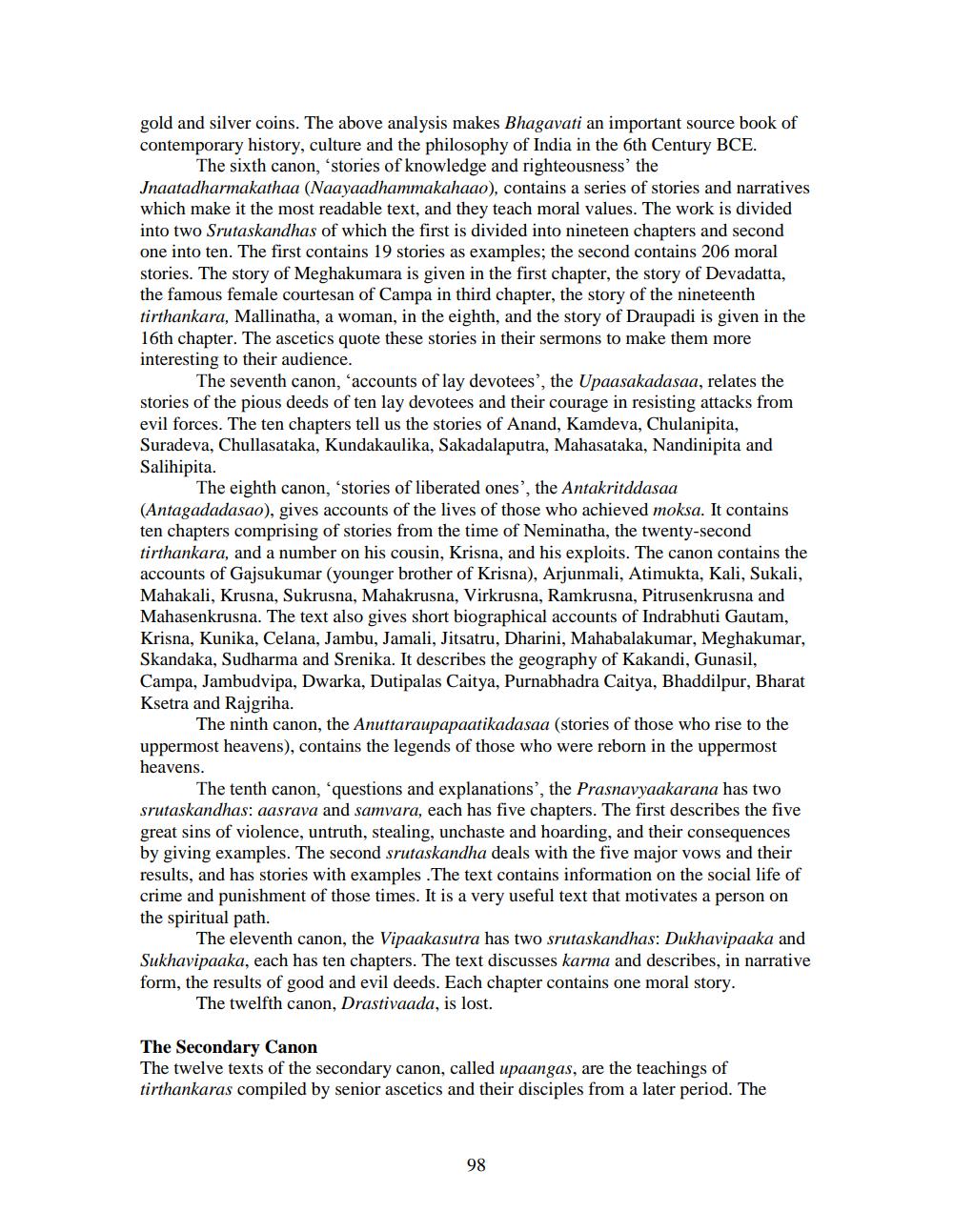________________
gold and silver coins. The above analysis makes Bhagavati an important source book of contemporary history, culture and the philosophy of India in the 6th Century BCE.
The sixth canon, 'stories of knowledge and righteousness' the Jnaatadharmakathaa (Naayaadhammakahaao), contains a series of stories and narratives which make it the most readable text, and they teach moral values. The work is divided into two Srutaskandhas of which the first is divided into nineteen chapters and second one into ten. The first contains 19 stories as examples; the second contains 206 moral stories. The story of Meghakumara is given in the first chapter, the story of Devadatta, the famous female courtesan of Campa in third chapter, the story of the nineteenth tirthankara, Mallinatha, a woman, in the eighth, and the story of Draupadi is given in the 16th chapter. The ascetics quote these stories in their sermons to make them more interesting to their audience.
The seventh canon, 'accounts of lay devotees', the Upaasakadasaa, relates the stories of the pious deeds of ten lay devotees and their courage in resisting attacks from evil forces. The ten chapters tell us the stories of Anand, Kamdeva, Chulanipita, Suradeva, Chullasataka, Kundakaulika, Sakadalaputra, Mahasataka, Nandinipita and Salihipita.
The eighth canon, 'stories of liberated ones', the Antakritddasaa (Antagadadasao), gives accounts of the lives of those who achieved moksa. It contains ten chapters comprising of stories from the time of Neminatha, the twenty-second tirthankara, and a number on his cousin, Krisna, and his exploits. The canon contains the accounts of Gajsukumar (younger brother of Krisna), Arjunmali, Atimukta, Kali, Sukali, Mahakali, Krusna, Sukrusna, Mahakrusna, Virkrusna, Ramkrusna, Pitrusenkrusna and Mahasenkrusna. The text also gives short biographical accounts of Indrabhuti Gautam, Krisna, Kunika, Celana, Jambu, Jamali, Jitsatru, Dharini, Mahabalakumar, Meghakumar, Skandaka, Sudharma and Srenika. It describes the geography of Kakandi, Gunasil, Campa, Jambudvipa, Dwarka, Dutipalas Caitya, Purnabhadra Caitya, Bhaddilpur, Bharat Ksetra and Rajgriha.
The ninth canon, the Anuttaraupapaatikadasaa (stories of those who rise to the uppermost heavens), contains the legends of those who were reborn in the uppermost heavens.
The tenth canon, 'questions and explanations', the Prasnavyaakarana has two srutaskandhas: aasrava and samvara, each has five chapters. The first describes the five great sins of violence, untruth, stealing, unchaste and hoarding, and their consequences by giving examples. The second srutaskandha deals with the five major vows and their results, and has stories with examples .The text contains information on the social life of crime and punishment of those times. It is a very useful text that motivates a person on the spiritual path.
The eleventh canon, the Vipaakasutra has two srutaskandhas: Dukhavipaaka and Sukhavipaaka, each has ten chapters. The text discusses karma and describes, in narrative form, the results of good and evil deeds. Each chapter contains one moral story. The twelfth canon, Drastivaada, is lost.
The Secondary Canon
The twelve texts of the secondary canon, called upaangas, are the teachings of tirthankaras compiled by senior ascetics and their disciples from a later period. The
98




